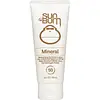What's inside
What's inside
 Key Ingredients
Key Ingredients

 Benefits
Benefits

 Concerns
Concerns

 Ingredients Side-by-side
Ingredients Side-by-side

Homosalate 5.5%
Skin ConditioningEthylhexyl Salicylate 4.5%
UV AbsorberOctocrylene 4%
UV AbsorberButyl Methoxydibenzoylmethane 2%
UV AbsorberC12-15 Alkyl Benzoate
AntimicrobialCetearyl Alcohol
EmollientPhenoxyethanol
PreservativeVp/Eicosene Copolymer
Diisopropyl Adipate
EmollientNeopentyl Glycol Diheptanoate
EmollientMica
Cosmetic ColorantDimethicone
EmollientGlycerin
HumectantParfum
MaskingPolymethylsilsesquioxane
Acrylates/C10-30 Alkyl Acrylate Crosspolymer
Emulsion StabilisingCoco-Glucoside
CleansingMethylparaben
PreservativePropylene Glycol Dibenzoate
Skin ConditioningCeteth-10 Phosphate
CleansingDicetyl Phosphate
EmulsifyingPropylparaben
PreservativeSodium Hydroxide
BufferingDisodium EDTA
Paraffin
PerfumingXanthan Gum
EmulsifyingButyrospermum Parkii Butter
Skin ConditioningJojoba Alcohol
EmollientPotassium Jojobate
Skin ConditioningSimmondsia Chinensis Butter
Skin ConditioningMangifera Indica Seed Butter
Skin ConditioningPropanediol
SolventTocopheryl Acetate
AntioxidantCarica Papaya Fruit Extract
Skin ConditioningColocasia Antiquorum Root Extract
Skin ConditioningMangifera Indica Fruit Extract
Skin ConditioningPassiflora Incarnata Fruit Extract
Skin ConditioningPlumeria Acutifolia Flower Extract
Skin ConditioningPsidium Guajava Fruit Extract
AstringentPanthenol
Skin ConditioningAloe Barbadensis Leaf Juice
Skin ConditioningSodium Ascorbyl Phosphate
AntioxidantTitanium Dioxide
Cosmetic ColorantHomosalate 5.5%, Ethylhexyl Salicylate 4.5%, Octocrylene 4%, Butyl Methoxydibenzoylmethane 2%, C12-15 Alkyl Benzoate, Cetearyl Alcohol, Phenoxyethanol, Vp/Eicosene Copolymer, Diisopropyl Adipate, Neopentyl Glycol Diheptanoate, Mica, Dimethicone, Glycerin, Parfum, Polymethylsilsesquioxane, Acrylates/C10-30 Alkyl Acrylate Crosspolymer, Coco-Glucoside, Methylparaben, Propylene Glycol Dibenzoate, Ceteth-10 Phosphate, Dicetyl Phosphate, Propylparaben, Sodium Hydroxide, Disodium EDTA, Paraffin, Xanthan Gum, Butyrospermum Parkii Butter, Jojoba Alcohol, Potassium Jojobate, Simmondsia Chinensis Butter, Mangifera Indica Seed Butter, Propanediol, Tocopheryl Acetate, Carica Papaya Fruit Extract, Colocasia Antiquorum Root Extract, Mangifera Indica Fruit Extract, Passiflora Incarnata Fruit Extract, Plumeria Acutifolia Flower Extract, Psidium Guajava Fruit Extract, Panthenol, Aloe Barbadensis Leaf Juice, Sodium Ascorbyl Phosphate, Titanium Dioxide
Zinc Oxide 20%
Cosmetic ColorantWater
Skin ConditioningCocos Nucifera Oil
MaskingButyloctyl Salicylate
Skin ConditioningDiheptyl Succinate
EmollientMethyl Dihydroabietate
Butyrospermum Parkii Butter
Skin ConditioningCapryloyl Glycerin/Sebacic Acid Copolymer
Skin ConditioningSodium Stearoyl Glutamate
CleansingCetearyl Alcohol
EmollientArachidyl Alcohol
EmollientCoco-Glucoside
CleansingTocopherol
AntioxidantTheobroma Cacao Seed Butter
EmollientCetyl Alcohol
EmollientBehenyl Alcohol
EmollientBisabolol
MaskingArachidyl Glucoside
EmulsifyingMicrocrystalline Cellulose
AbsorbentCellulose Gum
Emulsion StabilisingSodium Hyaluronate
HumectantSodium Gluconate
Skin ConditioningPhenoxyethanol
PreservativeCitric Acid
BufferingEthylhexylglycerin
Skin ConditioningPolyhydroxystearic Acid
EmulsifyingZinc Oxide 20%, Water, Cocos Nucifera Oil, Butyloctyl Salicylate, Diheptyl Succinate, Methyl Dihydroabietate, Butyrospermum Parkii Butter, Capryloyl Glycerin/Sebacic Acid Copolymer, Sodium Stearoyl Glutamate, Cetearyl Alcohol, Arachidyl Alcohol, Coco-Glucoside, Tocopherol, Theobroma Cacao Seed Butter, Cetyl Alcohol, Behenyl Alcohol, Bisabolol, Arachidyl Glucoside, Microcrystalline Cellulose, Cellulose Gum, Sodium Hyaluronate, Sodium Gluconate, Phenoxyethanol, Citric Acid, Ethylhexylglycerin, Polyhydroxystearic Acid
Ingredients Explained
These ingredients are found in both products.
Ingredients higher up in an ingredient list are typically present in a larger amount.
This ingredient is also known as shea butter. It is an effective skin hydrator and emollient.
Emollients help soothe and soften your skin. It does this by creating a protective film on your skin. This barrier helps trap moisture and keeps your skin hydrated. Emollients may be effective at treating dry or itchy skin.
Shea butter is rich in antioxidants. Antioxidants help fight free-radicals, or molecules that may harm the body. It is also full of fatty acids including stearic acid and linoleic acid. These acids help replenish the skin and keep skin moisturized.
While Shea Butter has an SPF rating of about 3-4, it is not a sunscreen replacement.
Shea butter may not be fungal acne safe. We recommend speaking with a professional if you have any concerns.
Learn more about Butyrospermum Parkii ButterCetearyl alcohol is a mixture of two fatty alcohols: cetyl alcohol and stearyl alcohol. It is mainly used as an emulsifier. Emulsifiers help prevent the separation of oils and products. Due to its composition, it can also be used to thicken a product or help create foam.
Cetearyl alcohol is an emollient. Emollients help soothe and hydrate the skin by trapping moisture.
Studies show Cetearyl alcohol is non-toxic and non-irritating. The FDA allows products labeled "alcohol-free" to have fatty alcohols.
This ingredient is usually derived from plant oils such as palm, vegetable, or coconut oils. There is debate on whether this ingredient will cause acne.
Due to the fatty acid base, this ingredient may not be Malassezia folliculitis safe.
Learn more about Cetearyl AlcoholCoco-Glucoside is a surfactant, or a cleansing ingredient. It is made from glucose and coconut oil.
Surfactants help gather dirt, oil, and other pollutants from your skin to be rinsed away.
This ingredient is considered gentle and non-comedogenic. However, it may still be irritating for some.
Learn more about Coco-GlucosidePhenoxyethanol is a preservative that has germicide, antimicrobial, and aromatic properties. Studies show that phenoxyethanol can prevent microbial growth. By itself, it has a scent that is similar to that of a rose.
It's often used in formulations along with Caprylyl Glycol to preserve the shelf life of products.